International Journal of Image, Graphics and Signal Processing @ijigsp
Статьи журнала - International Journal of Image, Graphics and Signal Processing
Все статьи: 1157

Статья научная
Ophthalmology is the study of structures, functions, treatment and disorders of eye. Computer aided analysis of retina images is still an open research area. Numerous efforts have been made to automate the analysis of retina images. This paper presents a review of various existing research in detection of anatomical structures in retina and lesions for the diagnosis of diabetic retinopathy (DR). The research in detection of anatomical structures is further divided into subcategories, namely, vessel segmentation and vessel centerline extraction, optic disc segmentation and localization, and fovea/ macula detection and extraction. Various research works in each of the categories are reviewed highlighting the techniques employed and comparing the performance figures obtained. The issues/ lacuna of various approaches are brought out. The following major observations are made: Most of the vessel detection algorithms fail to extract small thin vessels having low contrast. It is difficult to detect vessels at regions where close vessels are merged, at regions of missing of small vessels, at optic disc regions, and at regions of pathology. Machine learning based approaches for blood vessel tracing requires long processing time. It is difficult to detect optic disc radius or boundary with simple blood vessel tracing. Automatic detection of fovea and macular region extraction becomes complicated due to non-uniform illuminations while imaging and diseases of the eyes. Techniques requiring prior knowledge leads to complexity. Most lesion detection algorithms underperform due to wide variations in the color of fundus images arising out of variations in the degree of pigmentation and presence of choroid.
Бесплатно
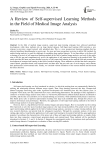
A Review of Self-supervised Learning Methods in the Field of Medical Image Analysis
Статья научная
In the field of medical image analysis, supervised deep learning strategies have achieved significant development, while these methods rely on large labeled datasets. Self-Supervised learning (SSL) provides a new strategy to pre-train a neural network with unlabeled data. This is a new unsupervised learning paradigm that has achieved significant breakthroughs in recent years. So, more and more researchers are trying to utilize SSL methods for medical image analysis, to meet the challenge of assembling large medical datasets. To our knowledge, so far there still a shortage of reviews of self-supervised learning methods in the field of medical image analysis, our work of this article aims to fill this gap and comprehensively review the application of self-supervised learning in the medical field. This article provides the latest and most detailed overview of self-supervised learning in the medical field and promotes the development of unsupervised learning in the field of medical imaging. These methods are divided into three categories: context-based, generation-based, and contrast-based, and then show the pros and cons of each category and evaluates their performance in downstream tasks. Finally, we conclude with the limitations of the current methods and discussed the future direction.
Бесплатно
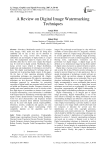
A Review on Digital Image Watermarking Techniques
Статья научная
Nowadays, Multimedia security [1] is a major issue. Images, video, audio, text files are losing their credibility day by day as they can be distorted or manipulated by using several tools. Ensuring the authenticity [2] and integrity of digital media is a major issue. The manipulation made by forgery tools are so smoothly done that we don’t even suspect that forgery may be involved in digital content. Multimedia data is facing several issues related to illegal distribution, duplication and manipulation of information conveyed by them. The digital watermarking [3] technique plays an important role in protecting digital content. In this paper, On the basis of their operating principles different watermarking techniques are categorized [4]. Attacks, applications and requirements [5] related to watermarking techniques are also discussed. Different watermarking techniques proposed by researchers for protecting copyrights of digital media are presented which are based on spatial and frequency domain. Frequency domain are getting much more attention due to use of wavelets which have high degree of resemblance to human visual system. In digital watermarking, secret information is embedded with original data for maintaining ownership rights of the digital content. Spatial domain watermarking techniques work over pixel characteristics and frequency domain watermarks concerned about different transformations that can be used with digital content. Imperceptibility, robustness, security, complexity and capacity are some requirements of the digital watermarking which completely depends on the algorithm used for watermarking.
Бесплатно
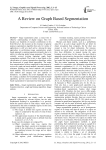
A Review on Graph Based Segmentation
Статья научная
Image segmentation plays a crucial role in effective understanding of digital images. Past few decades saw hundreds of research contributions in this field. However, the research on the existence of general purpose segmentation algorithm that suits for variety of applications is still very much active. Among the many approaches in performing image segmentation, graph based approach is gaining popularity primarily due to its ability in reflecting global image properties. This paper critically reviews existing important graph based segmentation methods. The review is done based on the classification of various segmentation algorithms within the framework of graph based approaches. The major four categorizations we have employed for the purpose of review are: graph cut based methods, interactive methods, minimum spanning tree based methods and pyramid based methods. This review not only reveals the pros in each method and category but also explores its limitations. In addition, the review highlights the need for creating a database for benchmarking intensity based algorithms, and the need for further research in graph based segmentation for automated real time applications.
Бесплатно
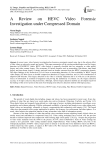
A Review on HEVC Video Forensic Investigation under Compressed Domain
Статья научная
In recent years, video forensic investigation has become a prominent research area, due to the adverse effect of fake videos on networks, people and society. This paper summarizes all the existing methodologies used for forgery detection in H.265/HEVC videos. HEVC video forgery is generally classified into two categories as video quality forgery and video content forgery. The occurrence of various forgeries such as transcoding, fake-bitrate, inter-frame forgery and intra-frame forgery is deeply analyzed based on features extracted from the HEVC compression domain. The major findings of this research are (i) Less focus on transcoding detection, (ii) Non-availability of HEVC forged video dataset (iii) More focus on double compression detection for forgery detection, and (iv) Non-consideration of adaptive-GOP structure. The forgery detection in the video is critically important due to its wide use as the primary source of information in criminal investigations and proving the authenticity of contents. So, the forgery detection accuracy is of major concern at the present time. Although, various forgery detection methods are developed in past but the findings of this review point out the need of developing more effective detection methods with high accuracy.
Бесплатно
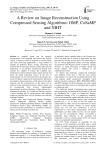
A Review on Image Reconstruction Using Compressed Sensing Algorithms: OMP, CoSaMP and NIHT
Статья научная
A sampled signal can be properly reconstructed if the sampling rate follows the Nyquist criteria. If Nyquist criteria is imposed on various image and video processing applications, a large number of samples are produced. Hence, storage, processing and transmission of these huge amounts of data make this task impractical. As an alternate, Compressed Sensing (CS) concept was applied to reduce the sampling rate. Compressed sensing method explores signal sparsity and hence the signal acquisition process in the area of transformation can be carried out below the Nyquist rate. As per CS theory, signal can be represented by alternative non-adaptive linear projections, which preserve the signal structure and the reconstruction of the signal can be achieved using optimization process. Hence signals can be reconstructed from severely undersampled measurements by taking advantage of their inherent low-dimensional structure. As Compressed Sensing, requires a lower sampling rate for reconstruction, data captured within the specified time will be obviously less than the traditional method. In this paper, three Compressed Sensing algorithms, namely Orthogonal Matching Pursuit (OMP), Compressive Sampling Matching Pursuit (CoSaMP) and Normalized Iterative Hard Thresholding (NIHT) are reviewed and their performance is evaluated at different sparsity levels for image reconstruction.
Бесплатно
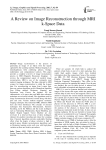
A Review on Image Reconstruction through MRI k-Space Data
Статья научная
Image reconstruction is the process of generating an image of an object from the signals captured by the scanning machine. Medical imaging is an interdisciplinary field combining physics, biology, mathematics and computational sciences. This paper provides a complete overview of image reconstruction process in MRI (Magnetic Resonance Imaging). It reviews the computational aspect of medical image reconstruction. MRI is one of the commonly used medical imaging techniques. The data collected by MRI scanner for image reconstruction is called the k-space data. For reconstructing an image from k-space data, there are various algorithms such as Homodyne algorithm, Zero Filling method, Dictionary Learning, and Projections onto Convex Set method. All the characteristics of k-space data and MRI data collection technique are reviewed in detail. The algorithms used for image reconstruction discussed in detail along with their pros and cons. Various modern magnetic resonance imaging techniques like functional MRI, diffusion MRI have also been introduced. The concepts of classical techniques like Expectation Maximization, Sensitive Encoding, Level Set Method, and the recent techniques such as Alternating Minimization, Signal Modeling, and Sphere Shaped Support Vector Machine are also reviewed. It is observed that most of these techniques enhance the gradient encoding and reduce the scanning time. Classical algorithms provide undesirable blurring effect when the degree of phase variation is high in partial k-space. Modern reconstructions algorithms such as Dictionary learning works well even with high phase variation as these are iterative procedures.
Бесплатно
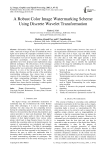
A Robust Color Image Watermarking Scheme Using Discrete Wavelet Transformation
Статья научная
Information hiding in digital media such as audio, video and or images in order to establish the owner rights and to protect the copyrights commonly known as digital watermarking has received considerable attention of researchers over last few decades and lot of work has been done accordingly. A number of schemes and algorithms have been proposed and implemented using different techniques. The effectiveness of the technique depends on the host data values chosen for information hiding and the way watermark is being embedded in them. However, in view of the threats posed by the online pirates, the robustness and the security of the underlying watermarking techniques have always been a major concern of the researchers. This paper presents a secure and robust watermarking technique for color images using Discrete Wavelet Transformation. The results obtained have shown that the technique is robust against various common image processing attacks.
Бесплатно
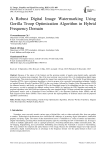
Статья научная
Because of the nature of the Internet and the growing number of people using digital media, copyright protection is becoming more important. One of the most common ways to protect this is by implementing digital image watermarking. This protection method safeguards the image from unauthorized access. The Gorilla Troop Optimization Algorithm (GTO), a new evolutionary algorithm, is what we propose to be a powerful watermarking technique. Initially, we applied Discrete Wavelet Transform (DWT) to the cover image, followed by Singular Value Decomposition (SVD) for enhanced security, and finally, we applied SVD to the Watermark image for its embedding into the cover image. In this process, we aim to optimize the multiple scaling factors (MSFs) by applying the GTO algorithm and testing the proposed algorithm in the MATLAB environment using some standard images. We then evaluated the experiment using performance metrics such as Normalized Cross-Correlation (NCC), the Structural Similarity Index (SSIM), and the Peak Signal-to-Noise Ratio (PSNR). These metrics proved the imperceptibility of different attacks and the proposed algorithm’s performance.
Бесплатно
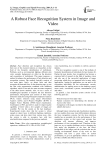
A Robust Face Recognition System in Image and Video
Статья научная
Face detection and recognition has always been one of the research interests to researchers in the field of the biometric identification of individuals. Problems such as environmental lighting, different skin color, complex background, etc affect on the detection and recognition of individuals. This paper proposes a method to enhance the performance of face detection and recognition systems. Our method, basically consists of two main parts: firstly, we detect faces and then recognize the detected faces. In the detection step, we use the skin color segmentation combined with AdaBoost algorithm, which is fast and also more accurate compared to the other known methods. Also, we use a series of morphological operators to improve the face detection performance. Recognition part consists of three steps: dimension reduction using Principal Component Analysis (PCA), feature selection using Linear Discriminant Analysis (LDA), and k-Nearest Neighbor (K-NN) or Support Vector Machine (SVM) based classification. Combination of PCA and LDA is used for improving the capability of LDA when a few samples of images are available. We test the system on the face databases. Experimental results show that the system is robust enough to detect faces in different lighting conditions, scales, poses, and skin colors from various races. Also, the system is able to recognize face with less misclassification compared to the previous methods.
Бесплатно
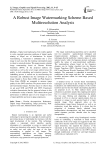
A Robust Image Watermarking Scheme Based Multiresolution Analysis
Статья научная
Digital watermarking has been widely applied to solve copyright protection problems of digital media relating to illegal use of distributions. In digital watermarking, a watermark is embedded into a cover image in such way that the resulting watermarked signal is robust to certain distortion. This paper presents a digital image watermarking based on Discrete Wavelet Transform (DWT). In the proposed method, the watermark as well as the cover image seldom looses the quality in both embedding and extraction process. The embedding process is carried out by tetra-furcating the watermark and embedded into the sub-bands of cover image. Signal to Noise Ratio (SNR) and Peak Signal to Noise Ratio (PSNR) are computed to measure image quality for the DWT transform. We present traces of host and watermarked images. From the traces we observe that, we get good SNR and PSNR with DWT. Experiment evaluation demonstrates that the proposed scheme is able to withstand a variety of attacks. This scheme shows good performance on different types of cover images in terms of imperceptibility and resist to jpeg compression.
Бесплатно
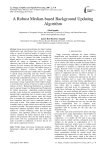
A Robust Median-based Background Updating Algorithm
Статья научная
Image processing techniques for object tracking, identification and classification have become common today as a result of improved quality of cameras as well as prices of cameras becoming cheaper and cheaper day by day. The use of cameras also make it possible for human analysis of video streams or images where it is difficult for robots or algorithms or machines to effectively deal with the images. However, the use of cameras for basic tracking and analysing do not come without challenges such as issues with sudden changes in illumination, shadows, occlusion, noise, and high computational time and space complexities of algorithms. A typical image processing task may involve several subtasks such as capturing, and pre-processing which demand high computational resources to complete. One of the main pre-processing tasks used in image processing is image segmentation which enables images to be divided into sections of interest in order to perform analysis on them. Background Subtraction is commonly used to segment images into Background and Foreground for further processing. Algorithms producing highly accurate results during this segmentation task normally demand high computation time or memory space, while algorithms that use smaller memory space and shorter time to complete this segmentation task may also suffer from limitations that may lead to undesired results at some point in time. Poor outputs from algorithms will eventually lead to system failure which must be avoided as much as possible. This paper proposes a median based background updating algorithm which determines the median of a buffer containing values that are highly correlated. The algorithm achieves this by deletingan extreme valuefrom the buffer whenever data is to be added to it.Experiments show that the method produces good results with less computational time which will make it possible to implement on devices that do not have much computation resources.
Бесплатно
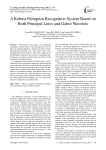
A Robust Palmprint Recognition System Based on Both Principal Lines and Gabor Wavelets
Статья научная
We present in this paper a new palmprint recognition system based on the principal lines of the palm. An original algorithm is proposed in order to detect automatically principal lines and extract their corre-spondent geometrical features. Given the complexity of the palmprint recognition and in order to ameliorate performances, we propose a hybrid approach based on both geometrical and gabor features. A comparative study between the three feature vectors obtained from the geometrical approach, global approach and combination of both has proved that the geometrical features are the most relevant since they can give the best compromise recognition Rate/Time. Moreover, a combination of geometrical features with global features can improve recognition rate while keeping the same recognition and learning times. Obtained results also show that the hybrid approach performances are very satisfactory and even surpass the very popular ones.
Бесплатно
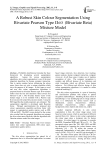
A Robust Skin Colour Segmentation Using Bivariate Pearson Type IIαα (Bivariate Beta) Mixture Model
Статья научная
Probability distributions formulate the basic framework for developing several segmentation algorithms. Among the various segmentation algorithms, skin colour segmentation is one of the most important algorithms for human computer interaction. Due to various random factors influencing the colour space, there does not exist a unique algorithm which serve the purpose of all images. In this paper a novel and new skin colour segmentation algorithms is proposed based on bivariate Pearson type II mixture model since the hue and saturation values always lies between 0 and 1. The bivariate feature vector of the human image is to be modeled with a Pearson type II mixture (bivariate Beta mixture) model. Using the EM Algorithm the model parameters are estimated. The segmentation algorithm is developed under Bayesian frame. Through experimentation the proposed skin colour segmentation algorithm performs better with respect to segmentation quality metrics such as PRI, VOI and GCE. The ROC curves plotted for the system also revealed that the proposed algorithm can segment the skin colour more effectively than the algorithm with Gaussian mixture model for some images.
Бесплатно
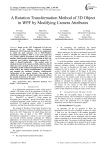
A Rotation Transformation Method of 3D Object in WPF by Modifying Camera Attributes
Статья научная
Based on the .NET Framework 2.0, the new generation of the windows software development framework .NET Framework 3.0 has four new components, in which the most attractive one is WPF(Windows Presentation Foundation). WPF is a new GUI engine that can provide uniform descriptions and methods for user interface, 2D/3D graphic, document and media. In WPF, the commonly used rotation transformation method for 3D object is RotateTransform3D. This method needs to calculate the state of the camera carefully, otherwise, the 3D object may move anomaly on the screen. To solve this kind of problem, another method is brought forward in the paper, which realizes the rotation transformation by calaulating and changing the attributes (Position, LookDirection, UpDirection) of the camera directly. The method can exhibite the rotation of 3D object distortion-freely, without the anomal movement on the screen. The calculation and the program of the method is simple.
Бесплатно
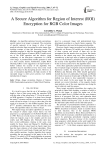
A Secure Algorithm for Region of Interest (ROI) Encryption for RGB Color Images
Статья научная
An algorithm optimized towards encrypting a specific region in an image is proposed. The encryption of specific region(s) in an image is often of more practical relevance than encrypting the entire image, thus avoiding wastage of time and processing power. The algorithm proposed is ideal for encrypting images with relatively small Region of Interest (ROI). It makes novel use of the XOR operation and the relative visual redundancy of the blue-plane components in a RGB color image. A pseudorandom number generator is used as a basic security feature. Furthermore, Cipher Block Chaining (CBC) is also suggested as an improvement to further enhance the security of the algorithm. The algorithm may be classified as lossy since some visual data is sacrificed in the decrypting process. However, in case of encryption algorithms, the high security of the encrypted image is often given priority over faithful reproduction of images.
Бесплатно
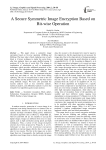
A Secure Symmetric Image Encryption Based on Bit-wise Operation
Статья научная
This paper shows a symmetric image encryption based on bit-wise operation (XORing and Shifting). The basic idea is block ciphering (size of each block is 4 bytes) technique to cipher the secret bytes, after that ciphered bytes are again shuffled among N positions (N is the size of secret file). The scheme is combination of substitution as well as transposition techniques which provides additional protection of the secret data. The substitution and transposition are done using dynamic substitution box (SBOX) and transposition box (TBOX) which are generated using the secret key and made to vary for each block during ciphering. The size of encrypted data is same as the size of secret data and the proposed scheme has been tested using different images. We have also presented the security analysis such as key sensitivity analysis, statistical analysis, and differential analysis to prove the strength of our algorithm against crypto analysis.
Бесплатно
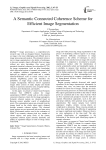
A Semantic Connected Coherence Scheme for Efficient Image Segmentation
Статья научная
Image processing is a comprehensively research topic with an elongated history. Segmenting an image is the most challenging and difficult task in image processing and analysis. The principal intricacy met in image segmentation is the ability of techniques to discover semantic objects efficiently from an image without any prior knowledge. One recent work presented connected coherence tree algorithm (CCTA) for image segmentation (with no prior knowledge) which discovered regions of semantic coherence based on neighbor coherence segmentation criteria. It deployed an adaptive spatial scale and a suitable intensity-difference scale to extract several sets of coherent neighboring pixels and maximize the probability of single image content and minimize complex backgrounds. However CCTA segmented images either consists of small, lengthy and slender objects or rigorously ruined by noise, irregular lighting, occlusion, poor illumination, and shadow. In this paper, we present a Cluster based Semantic Coherent Tree (CBSCT) scheme for image segmentation. CBSCT's initial work is on the semantic connected coherence criteria for the image segregation. Semantic coherent regions are clustered based on Bayesian nearest neighbor search of neighborhood pixels. The segmentation regions are extracted from the images based on the cluster object purity obtained through semantic coherent regions. The clustered image regions are post processed with non linear noise filters. Performance metrics used in the evaluation of CBSCT are semantic coherent pixel size, number of cluster objects, and purity levels of the cluster, segmented coherent region intensity threshold, and quality of segmented images in terms of image clarity with PSNR.
Бесплатно
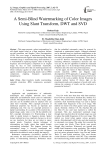
A Semi-Blind Watermarking of Color Images Using Slant Transform, DWT and SVD
Статья научная
This paper presents a robust watermarking for still digital images based on a Slant transform, discrete wavelet transforms and Singular Value Decomposition (SVD). The cover image is transformed using discrete wavelet transform and singular value decomposition while watermark image is transformed using slant transform. It is watermarked by replacing singular values of the high-frequency and low-frequency component of an original image by that of slant transformed watermarks. Experimental results show that our method guarantees the robust resistance against no attack and the robustness against common image processing attacks such as JPEG compression, cropping, histogram equalization, sharpening etc.
Бесплатно
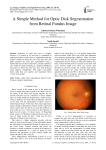
A Simple Method for Optic Disk Segmentation from Retinal Fundus Image
Статья научная
Detection of optic disc area is complex because it is located in an area that is considered as pathological blood vessels when in segmentation and thus require a method to detect the area of the optic disc, this paper proposed the optic disc segmentation using a method that has not been used before, and this method is very simple, K-means clustering is a proposed Method in this paper to detect the optic disc area with perfected using adaptive morphology. This paper successfully detect optic disc area quickly and segmented blood vessels more quickly.
Бесплатно

